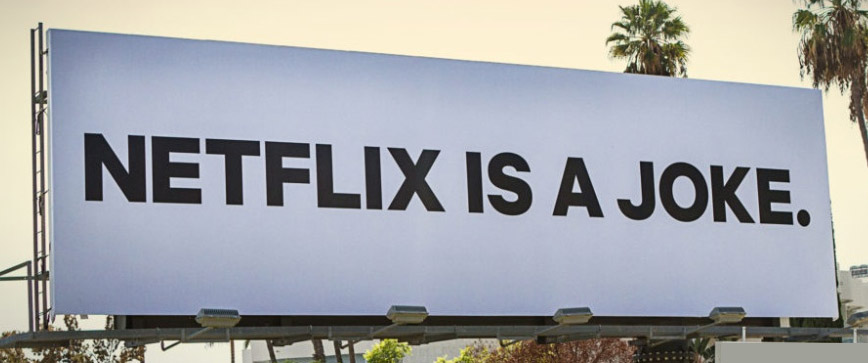
When Netflix bought about three dozen billboards on the Sunset Strip last summer, people took notice. Netflix is known as an innovator, a ground-shaker. When it makes a move, especially one people didn’t anticipate, everyone watches.
Turns out Netflix was, as usual, a harbinger of things to come. Over the past year, at a time when so many businesses have beaten a retreat from traditional advertising such as TV and newspapers, tech companies are running in the other direction, toward one particular traditional medium — billboards.
Why? Well, the short answer is because it’s effective, but duh…anytime an influx of spending comes in, it’s pretty clear that medium is effective.
The longer answer is that tech companies approach advertising differently than other businesses. They aren’t blinded by bells and whistles. They’re thrilled by data and results. They’re thrilled by innovation. They’re thrilled by creativity. And out of home (OOH) advertising has all three.
Let’s Do the Numbers: Tech Spending on Billboards in 2018
So before we dive into the “why” behind the tech companies’ devotion to billboards, let’s examine the “what.”
OOH advertising ended 2018 on a tear by any standards, but especially using the ones we’ve become used to judging traditional media by. These days, finishing even to the previous year is like finishing 5 percent up during the early 2000s.
OOH closed fourth quarter with an astonishing 7.2 percent rise in spending vs. the same period in 2017, according to OAAA. That made it the best quarterly gain since before 2008, when the Great Recession hit. Some other highlights:
- Apple was the top-spending advertiser in OOH in 2018, the sixth straight year it has ranked in the top two. Netflix and Google finished in the top 10. Amazon and Facebook made the top 15.
- A quarter of all top 100 advertisers were from the technology sector, with Facebook and Oculus both more than doubling the previous year’s investment in OOH.
Speaking of spending, Netflix is now a billboard owner, but it’s keeping all the inventory for itself. You won’t see the streaming company leasing space to a nearby fast food restaurant. It knows the value of that real estate and has kept a steady rotation of advertisements for its latest shows coming through. (And with Netflix forecast to spend $15 billion on content this year, it could run a fresh ad every week and never repeat.)
So clearly tech companies are on board with boards. Now let’s look at the “why.”
OOH Data: Compelling Evidence Supports Billboards’ Results
Big data has been the cool thing in all spheres of advertising for years now. There’s a reason for that — it works. When you use big data to analyze, say, when people who like chocolate milk will be shopping, you can hit them up with a chocolate milk billboard at the moment they make their decision. It’s much more likely your campaign will be convincing if you know that kind of stuff about your target audience.
And OOH has proven adept at relying on this research. Right place, right time ads make a difference. Consider these OOH advertising facts:
- OOH is 382 percent more effective at sending people online to learn about an advertiser than TV
- OOH generates $5.97 in spending for every $1 an advertiser drops
- 55 percent of people who’ve seen a billboard say they were “highly engaged” by its message
Innovation: Ditching Inaction and Embracing Impulse
Tech companies are driven by results. Most began as startups and haven’t had decades and decades to get settled into staid patterns of thinking. They are more nimble and flexible than older companies in more traditional spaces.
Lots of tech companies engage in “design thinking,” which emphasizes action over endless focus groups and actually engaging with customers. Digital billboards fit perfectly with this mentality.
Digital OOH offers ways to act immediately on new ideas. You just email your creative to the vendor, and boom! You can have a new billboard up in moments.
Design thinking encourages flexibility and versatility, which is another area where billboards (especially digital) shine. Current creative not doing it for you? Swap in something else. You can experiment as you go along and see what’s most effective. Netflix has a great opportunity to do this with its billboard buy.
Creativity: Using Old Media in New Ways
If you want to see innovation in advertising creative, you really need to look at OOH. Yeah, we’re biased, we’re an OOH agency. But really — the stuff people are doing is cool, and it’s getting talked about.
Tech companies like generating buzz. They like being seen as innovative. So while billboards are old media, they’re not without flexibility. And that’s exciting to these brands. Here are a few examples of out-of-the box campaigns they’ve run in recent years:
- Microsoft posted a billboard that disappeared and reappeared through a shadow effect
- Apple took over the side of a building in Vegas to spoof the “What happens in Vegas, stays in Vegas” trop before CES in early 2019, gaining loads of attention
- A billboard for Google Play streams music based on what’s going on around the board; so, for instance, it might play soothing classical music when there are traffic jams on the highway
These are the types of campaigns that get people talking on social media. They not only raise awareness of product, they also give the companies buzz. And in tech, buzz is currency. Consumers want to know tech companies are on the cutting edge in everything they do.
We’ll likely see more tech companies join the stampede of OOH advertisers over the next few years. It’s fun to see what they come up with without the type of boundaries that often seem to curtail the creativity of more traditional, formal companies.
Published: April 30, 2019